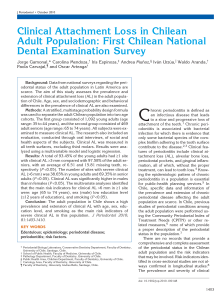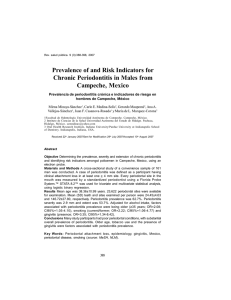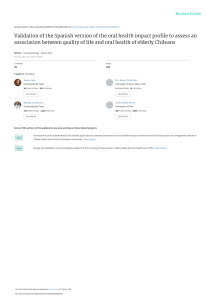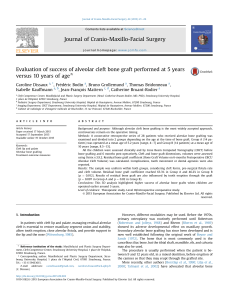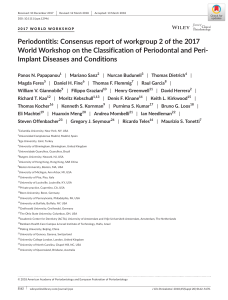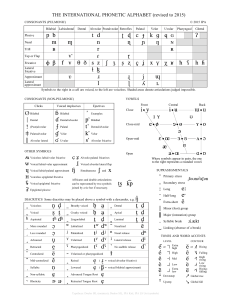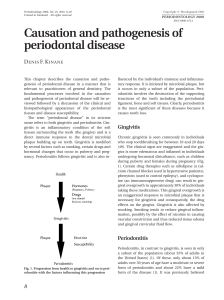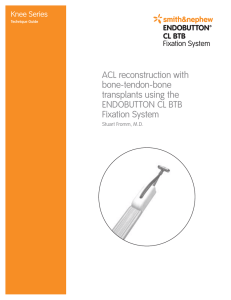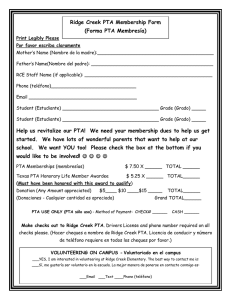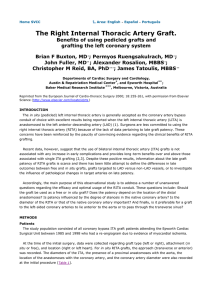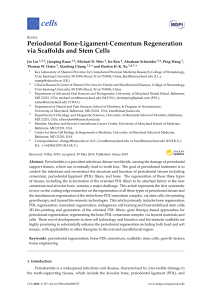Alveolar ridge increase with soft tissue autologous
Anuncio
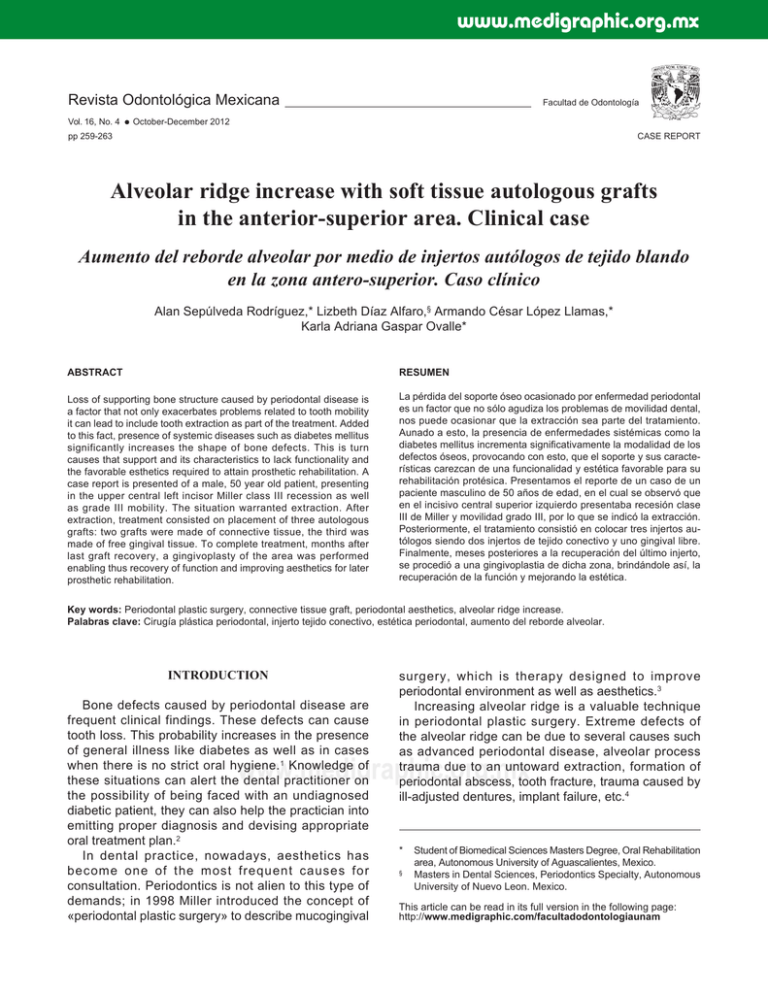
www.medigraphic.org.mx Revista Odontológica Mexicana Vol. 16, No. 4 Facultad de Odontología October-December 2012 CASE REPORT pp 259-263 Alveolar ridge increase with soft tissue autologous grafts in the anterior-superior area. Clinical case Aumento del reborde alveolar por medio de injertos autólogos de tejido blando en la zona antero-superior. Caso clínico Alan Sepúlveda Rodríguez,* Lizbeth Díaz Alfaro,§ Armando César López Llamas,* Karla Adriana Gaspar Ovalle* ABSTRACT RESUMEN Loss of supporting bone structure caused by periodontal disease is a factor that not only exacerbates problems related to tooth mobility it can lead to include tooth extraction as part of the treatment. Added to this fact, presence of systemic diseases such as diabetes mellitus significantly increases the shape of bone defects. This is turn causes that support and its characteristics to lack functionality and the favorable esthetics required to attain prosthetic rehabilitation. A case report is presented of a male, 50 year old patient, presenting in the upper central left incisor Miller class III recession as well as grade III mobility. The situation warranted extraction. After extraction, treatment consisted on placement of three autologous grafts: two grafts were made of connective tissue, the third was made of free gingival tissue. To complete treatment, months after last graft recovery, a gingivoplasty of the area was performed enabling thus recovery of function and improving aesthetics for later prosthetic rehabilitation. La pérdida del soporte óseo ocasionado por enfermedad periodontal es un factor que no sólo agudiza los problemas de movilidad dental, nos puede ocasionar que la extracción sea parte del tratamiento. Aunado a esto, la presencia de enfermedades sistémicas como la diabetes mellitus incrementa significativamente la modalidad de los defectos óseos, provocando con esto, que el soporte y sus características carezcan de una funcionalidad y estética favorable para su rehabilitación protésica. Presentamos el reporte de un caso de un paciente masculino de 50 años de edad, en el cual se observó que en el incisivo central superior izquierdo presentaba recesión clase III de Miller y movilidad grado III, por lo que se indicó la extracción. Posteriormente, el tratamiento consistió en colocar tres injertos autólogos siendo dos injertos de tejido conectivo y uno gingival libre. Finalmente, meses posteriores a la recuperación del último injerto, se procedió a una gingivoplastia de dicha zona, brindándole así, la recuperación de la función y mejorando la estética. Key words: Periodontal plastic surgery, connective tissue graft, periodontal aesthetics, alveolar ridge increase. Palabras clave: Cirugía plástica periodontal, injerto tejido conectivo, estética periodontal, aumento del reborde alveolar. INTRODUCTION Bone defects caused by periodontal disease are frequent clinical findings. These defects can cause tooth loss. This probability increases in the presence of general illness like diabetes as well as in cases when there is no strict oral hygiene.1 Knowledge of these situations can alert the dental practitioner on the possibility of being faced with an undiagnosed diabetic patient, they can also help the practician into emitting proper diagnosis and devising appropriate oral treatment plan.2 In dental practice, nowadays, aesthetics has become one of the most frequent causes for consultation. Periodontics is not alien to this type of demands; in 1998 Miller introduced the concept of «periodontal plastic surgery» to describe mucogingival surgery, which is therapy designed to improve periodontal environment as well as aesthetics.3 Increasing alveolar ridge is a valuable technique in periodontal plastic surgery. Extreme defects of the alveolar ridge can be due to several causes such as advanced periodontal disease, alveolar process trauma due to an untoward extraction, formation of periodontal abscess, tooth fracture, trauma caused by ill-adjusted dentures, implant failure, etc.4 www.medigraphic.org.mx * § Student of Biomedical Sciences Masters Degree, Oral Rehabilitation area, Autonomous University of Aguascalientes, Mexico. Masters in Dental Sciences, Periodontics Specialty, Autonomous University of Nuevo Leon. Mexico. This article can be read in its full version in the following page: http://www.medigraphic.com/facultadodontologiaunam Sepúlveda RA et al. Alveolar ridge increase with soft tissue 260 Extreme ridge resorption causes aesthetic problems, especially in the anterior region of the upper jaw. Several restorative prosthetic techniques have been developed to solve this problem. Several surgical techniques can be used according to the case to increase the alveolar ridge. Langer and Calagna introduced a technique which consisted in dealing with subepithelial connective tissue grafts. 5 Garber and Rosenberg introduced the technique of connective tissue graft after preparing a sac-shaped flap in the receptor bed.6 The aim of the present article was to present a clinical case showing functional and aesthetic advantages of soft (connective) tissue autologous grafts in a patient. CLINICAL CASE PRESENTATION A 50 year old male patient attended the dental office requesting total mouth rehabilitation. As personal pathological history, the patient informed of an ongoing for 7 years type II diabetes mellitus, controlled with metphormin and glibenclamide. The patient informed he had been wearing a bilateral, flexible, removable dental prosthesis for about four years. Intra-oral exploration revealed pathological migration (extrusion) of tooth number 21, Miller class III recession,7 class III mobility; all these factors seriously affected aesthetics as well as function (Figure 1). A diagnosis of severe chronic periodontitis was emitted. Periapical X-rays of the area revealed severe bone resorption caused by periodontal damage, as well as a periapical lesion. The case then presented a combined endodontic and periodontal problem (Figure 2). To solve this problem, due to the aforementioned facts, extraction of the tooth was indicated. Extraction would eradicate the established infection focus and thus avoid possible later complications. At approximately seven months after extraction, tissues had healed completely (Figures 3 and 4). Nevertheless, the situation of the alveolar process was not ideal to conduct rehabilitation. This was due to the presence of a Seiberts class III situation8 (Table I). Therefore, height and width of the alveolar process were restored with placement of soft tissue auto-grafts. In the first procedure, a connective tissue autologous graft was placed. The graft was harvested from the palate area 9 (donor area) and placed on the surgical bed (receiving area). A partial thickness flap was manufactured to later hold the graft into the periosteum. (Figures 5 to 7). Seven months later, Figure 1. Intraoral picture shows Class III Miller recession and extraction of upper left central incisor. Figure 2. Periapical X-ray showing extensive bone loss and periapical lesion. www.medigraphic.org.mx Figure 3. Intra-oral picture showing class III defect. Figure 4. Occlusal view showing palatine-vestibular depression. Revista Odontológica Mexicana 2012;16 (4): 259-263 261 the second autologous graft was placed. This was a free gingival graft (Figures 8 to 10). 10 Four months later, another connective tissue graft was placed, with envelope technique, to confer greater vestibular volume (Figures 11 to 13). 11 Five months into the recovery process, a gingivoplasty of the area was performed to dispose of irregular areas caused by scarring due to previous surgical procedures (Figures 14 to 16). The patient thus recovered function and benefited of improved esthetics (Figure 17). Table 1. Seibert’s classification of ridge deformities. Type of defect Morphological characteristics Class I Loss of tissue thickness (vestibular-palatine) Class II Loss of tissue height (apical-crown) and normal thickness Class III Tissue loss in thickness and height www.medigraphic.org.mx Figure 5. Intra-oral picture, showing harvesting of connective tissue graft. Figure 6. Intra-oral picture showing fixation of graft to surgical bed. Figure 7. Intra-oral picture showing closure and suture of graft. Sepúlveda RA et al. Alveolar ridge increase with soft tissue 262 Figure 8. Intra-oral picture, showing harvesting of free gingival graft. Figure 9. Intra-oral picture showing graft Figure 10. Intra-oral picture showing placement and suture. lack of tissue to cover ovoid pontic. Figure 11. Intra-oral picture, showing incision in envelope shape for the third graft. Figure 12. Picture showing connective tissue auto-graft harvested from the palate. Figure 13. Intra-oral picture showing graft placement into surgical bed. Figure 14. Intra-oral picture showing tissue increase towards apical-crown area. Figure 15. Intra-oral picture showing vestibular-palatine increase. www.medigraphic.org.mx Figure 16. Initial intra-oral picture taken before prosthetic and periodontal treatments. Figure 17. Intra-oral picture. Final result, excellent aesthetic improvement can be observed. Revista Odontológica Mexicana 2012;16 (4): 259-263 263 DISCUSSION In the present case, the patient presented several complications, among them, poor aesthetics in the anterior-superior area. These anomalies were aggravated by periodontal disease. Although the patient´s glucose was controlled, he observed poor oral hygiene, and this caused further damage to periodontal structures. 12 Treatment used for periodontal rehabilitation was described by Langer and Calagna in 1980; they employed a technique to correct ridge defects which consisted on sub-epithelial connective tissue grafts with the aim of improving aesthetics.5 One year later, Garber and Rosenberg introduced the technique of placing a connective tissue graft after preparing a sac-shaped flap in the receptor bed, with the aim of increasing the ridge so as to later place a fixed prosthesis. 6 In 1988 Miller introduced the concept of «periodontal plastic surgery» which described periodontal surgery engaged in improving aesthetics. 3 The aforementioned techniques were used with the patient subject of this study and resulted in highly satisfactory aesthetic results. CONCLUSIONS Defects of the alveolar ridge are frequent after tooth extraction or periodontal disease, affecting thus function and aesthetics. Presently there are periodontal surgical techniques which can be used to correct these defects and thus obtain excellent results. REFERENCES 1. Arrieta J, Bartolomé B, Jiménez E, Saavedra P, Arrieta F. Problemas bucodentales en pacientes con diabetes mellitus. Med Oral 2003; 8: 97-109. 2. Rees, TD. El paciente odontológico diabético. JS Clínicas Odontol. Norteamérica: Consideraciones prácticas en el cuidado de pacientes especiales. Interamericana; 1994: 423-40. 3. Miller PD Jr. Regenerative and reconstructive periodontal plastic surgery. Mucogingival surgery. Dent Clin North Am 1988; 32: 287-306. 4. Henriques PG. Estética en periodoncia y cirugía plástica periodontal. Santos-Amolca; 2006. 5. Langer B, Calagna LJ. The subepithelial connective tissue graft. J Prosthet Dent 1980; 44: 363-67. 6. Garber DA, Rosenberg ES. The edentulous ridge in fixed prosthodontics. Compend Cont Educ Dent 1981; 2: 212-233. 7. Miller PD Jr. A classification of marginal tissue recession. Int J Periodont Restor Dent 1985; 59: 9. 8. Seiber JS. Reconstruction of deformed, partially edentulous ridges, using full-thickness only grafts: Part 1. Technique and wound healing. Compend Cont Educ Dent 1983; 4: 437-53. 9. Studer SE et al. The thickness of masticatory mucosa in the human hard palate and tuberosity as potential donor sites for ridge augmentation procedures. J Periodontol 1997; 28: 145-51. 10. Meltzer JA. Edentulous area tissue graft correction of an esthetic defect. A case report. J Periodontol 1979; 50: 320-22. 11. Siebert JS. Ridge augmentation to enhance esthetics in fixed prosthetic treatment. Compend Cont Educ Dent 1991; 12: 548-61. 12. William RC, Mahan CJ. Periodontal disease and diabetes in young adults. JAMA 1960; 172: 776-778. Mailing address: Alan Sepúlveda Rodríguez Calle Colima 110, Frac. Gómez, 20060 Telephone: (449) 9 181850 E-mail: medesto@hotmail.com www.medigraphic.org.mx
